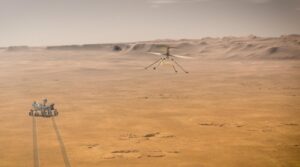Helicopter and other technology demos hitch a ride on Mars 2020
By Jeff Foust

WASHINGTON — While the primary focus of the Mars 2020 mission will be the search for evidence of past Martian life, the rover mission carries several other payloads that could support future robotic and human missions to the red planet.
Perhaps the highest profile of these payloads is a small helicopter, called Ingenuity, that will attempt to make the first powered flight in the Martian atmosphere. The 1.8-kilogram helicopter, attached to the belly of the Perseverance rover, will be deployed early in the mission for flight tests.
“Mars Helicopter is a technology demonstration motivated by the potential to add an aerial dimension to space exploration,” MiMi Aung, project manager for Ingenuity at the Jet Propulsion Laboratory, said at a Feb. 16 briefing. “It’s been fully tested as much as we can on Earth. Next, it’s time to demonstrate, prove and learn how it operates on Mars.”
After the Perseverance rover lands, it will drive to a nearby location that controllers believe is best suited for the helicopter test. It will release Ingenuity, a complex process that takes about 10 days to complete, then drive a safe distance away.
A first flight will go to an altitude of three meters, hovering for 20 seconds before landing. “It will truly be a Wright Brothers’ moment, but on another planet,” she said.
If successful, up to four more flights could follow over 30 days. Those flights, up to 90 seconds long, will go to altitudes of three to five meters and travel as much as 50 meters downrange, returning to an “airfield” landing zone 10 meters on a side.
The $85 million project, intended as a technology demonstration, has not been without controversy. Some scientists involved with Mars 2020 opposed the inclusion of the helicopter, arguing that those tests would take time away from rover operations during the initial phases of the mission. However, with the support of then NASA Administration Jim Bridenstine, the agency decided in May 2018 to fly the helicopter, later named Ingenuity, on the mission.
If successful, Ingenuity could pave the way for flying more advanced helicopters on future robotic and crewed missions, serving as scouts. “I think Ingenuity is today’s Sojourner,” said Matt Wallace, deputy project manager for Mars 2020, during a Feb. 17 briefing. Sojourner was NASA’s first Mars rover, flown on the Mars Pathfinder mission that landed in 1997.
Wallace, who worked on Sojourner, recalled there was skepticism at the time of the Mars Pathfinder mission whether a rover would be useful. “We found very quickly that having a mobile capability on the surface of Mars was incredibly valuable,” he said. “I think in almost every way, when you look at Ingenuity, it looks very much the same.”
On Perseverance itself, most of its payloads are science instruments intended to study the planet and look for evidence of past life. One, though, is a demonstration of technology for producing oxygen on Mars. The Mars Oxygen In Situ Resource Utilization (ISRU) Experiment, or MOXIE, will attempt to convert carbon dioxide in the Martian atmosphere into oxygen.
Such a technology is critical for future human missions to Mars, enabling crews to produce oxygen needed for both life support and propellant. The use of ISRU technologies for propellant production in particular makes human missions much more feasible, noted Jeff Sheehy, chief engineer for NASA’s Space Technology Mission Directorate, at a Feb. 16 briefing.
MOXIE will be turned on three times in the first 30 days after landing, with the first two to test the payload. “On the third run, we’ll actually make oxygen under some conservative operating conditions,” Sheehy said. MOXIE will be run at least 10 times over the course the mission, testing its ability to produce oxygen at different times of day and seasons of the year.
Each run of MOXIE will be about an hour, producing 6 to 10 grams of oxygen. The technology would need to be scaled up by about a factor of 200 for use on future crewed missions, but the agency hopes to at least prove the technology works on this mission.
The experiment did face a number of development changes that raised questions about whether it could be flown on Mars 2020. “There were times where some of the managers worried that the technology couldn’t be developed in time to get it on the rover,” he said. “There’s no question that the team that designed, built and tested MOXIE needed a lot of moxie to overcome all the challenges that were encountered along the way.”
Another instrument, SuperCam, features a laser that will be used to zap rocks, allowing it to analyze its chemical composition. An additional aspect of that instrument is a microphone that will listen as the laser fires, which can give scientists clues to the hardness and other properties of the rocks.
The microphone will have other applications as well. “It will listen to the wind, listen to the rover and also the infrared laser,” Sylvestre Maurice, deputy principal investigator for SuperCam, at a Feb. 16 briefing. “It’s the first time that we’ll have a microphone on Mars.”
The microphone, he said, will allow scientists to study atmospheric turbulence by listening to the wind. In the tenuous atmosphere of Mars, sound propagates differently from Earth, doing so at slower speeds and supporting lower frequencies better than higher ones. The microphone can also provide diagnostic information about the rover itself. “It’s opening a new world,” Maurice said.
February 18, 2021 at 06:24PM
via SpaceNews read more...

Post a Comment